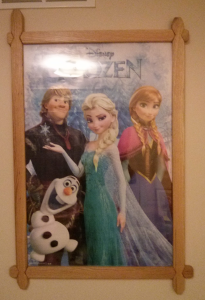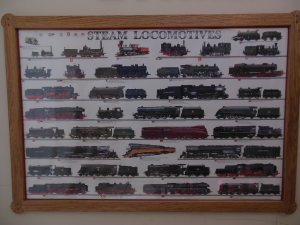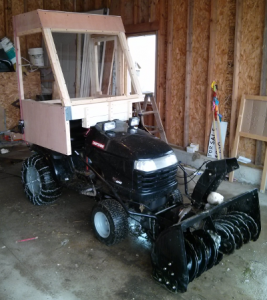A little while back while visiting the in-laws my daughter found a penny or nickel while exploring the house. Grandma, ever so kind, told her she could keep the coin. The next day around dinner time I offered her a nickel to clear the dining room table before dinner which she sort of figured out how to do. When she was done I offered, “Great, now you can go put this nickel with the coin grandma gave you yesterday.” And she sadly replied, “I lost that one.” “Well, we’re going to have to do something about that then.”
I remembered back a while on another visit to the in-laws we came across my wife’s old piggy bank. It was a teddy bear shape with the body section hollowed out and a piece of plexiglass screwed onto each side. Over all it would be a simple project which had some distinct aspects which would allow me to bring the kids into the shop. I figured it was time to invite them into the shop and introduce them to one of daddy’s hobbies. Especially after the excitement the half lap poster frame project recently.
The first step of the project was to have the kids help me find the pictures they wanted to use for the shape for their respective piggy banks. Ethan loves two things: the letter Q and trains. Figuring there wasn’t going to be a way to get the Q to stand up on it’s own I figured it best to go with trains. And Seraphina loves, well, all things girly. And butterflies happened to be on my mind when looking for things girly so she helped pick the one we used.
The next step brought me into the shop by myself to find some wood which would support the size of the pictures I had printed out. I still had some 1 1/2″ material reclaimed from a remodel my folks did on their place by Hubbard Lake. An many of the pieces were quite wide. What I didn’t know until later was that the piece I chose had some severe checking which required some glueing and clamping to put back together. A quick bit of spray adhesive and the templates were on the chunks of wood selected. I then took the blanks over to the drill press and put some interior holes which I would cut between when cutting out the bulk of the material.
This was the first project I extensively used the new scroll saw from my folks for Christmas. It is probably not the ideal use since I was going through 1 1/2″ material, but it was better than a previous attempt with a bandsaw since it didn’t leave a cut the width of the kerf that had to be clamped and glued shut. Seraphina seemed to enjoy watching the work at first from a stool, but after a while the noise got too much and I had to finish it up all by my lonesome. Unfortunately due to battery issues the segment with Ethan was lost. Much of the sanding video was also lost due to the same battery issues (but no one wants to watch that anyway).
Some glue was used here to reattach a piece which had split due to checking. I used grain filler to plug up some of the holes in the grain and checking. This also works nice for any flaws and in general just makes the final result much smoother. Hand sanding smoothes things out enough and since there will be several coats of paint over the whole project.
Piggy banks need coin slots so I took each bank over to the drill press. On the train I drilled out the smoke stack wide enough for the coins to slide down, just like if I were to create a mortise. Then using a hand drill, chisel, file, and sand paper the throat of the slot was cleaned up and smoothed out. The butterfly was much easier since the slot was only as thick as the wall of the bank. The same technique was used as before, but much more quickly.
The next step was to trace out the shapes on the plexiglass I was going to use for the sides. On the butterfly I did the inside and outside. On the train it was just the inside. In retrospect using a sharpie was a bad plan, as later the lines wound up showing through the paint and finish. I used the scroll saw to cut out the shapes which was less effective as you would expect. I only had very fine tooth scroll saw blades which seemed to warm up the plexiglass as I was cutting and weld it back together after the cut. When I was careful I could break off the cuts, but I still needed to run the edges over the sander or bandsaw to clean them up.
I put a couple coats of black paint on the train (trains are black, right?) and a couple coats of white on the butterfly. I brought in the expert painters. Seraphina did a great job. She started making everything symmetrical across the butterfly. Though right at the end she took some artistic license and broke the symmetry. Ethan, well, he probably made the red door the Mick Jagger wanted painted black. So he ever so carefully globbed the red paint ever so artistically all over the train. I suppose I should have anticipated that, but if I had painted it red he’d have had nothing to do. We also had a small disagreement of the proper use for gloves which I lost. Later I put a couple coats of lacquer on each of the bank. Though that caused the sharpie line to show through, I suppose something in the thinner in the lacquer did that.
The final step for the project was the align the plexiglass on the sides of the banks. I taped them down and pre-drilled the plexiglass with a bit wide enough so that even the screw threads would pass through, otherwise the plexiglass would shatter when putting the screws in. Then I followed up with a narrower bit where the threads would engage in the wood. On the train bank I used a countersink bit to open up for the wood screw heads. And then the sides were screwed on and a couple coins put into each of the banks for the kids.
One of the issues I’ve been running into for each of the videos is the limited battery life of the camera I was using, a Coolpix 6300. The issue comes from the use of the battery, which is specific to the camera and I couldn’t find a charger other than the camera itself. Towards the end I was getting less than 45 minutes on one battery and 2 minutes on the other battery. So there was a ton of down time or missed video. The quality of the video was great, but the lack of battery life just made it unusable. The Fuji Film S8200 just arrived this weekend which uses AA batteries. The video quality seems a little less in the lower light shots, but it has a couple advantages. The primary being availability of batteries and chargers. It also can record in stereo, which I am not sure is a big feature. The second is the 40x zoom, which probably won’t come into play too often in project videos. A drawback is the failure of the engineers to allow the removal of the batteries and memory card while the mount is screwed into the bottom of the camera.
Music Links
http://freemusicarchive.org/music/Jahzzar/


